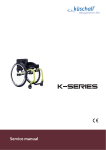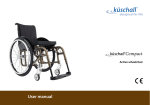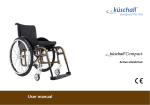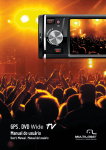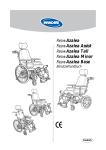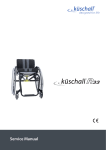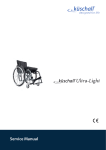Download Service Manual
Transcript
Service Manual Service Manual Contents General ......................................................................................................................... 4 Introduction 4 Spare parts 4 Tipping point of the wheelchair 4 Fastening with hexagon socket bolts 4 Visual check 5 Identifying and repairing faults 5 Frame ............................................................................................................................ 6 Adjusting the frame 6 Changing the frame 6 Seat ............................................................................................................................... 7 Adjusting the seat height 7 Replacing the seat cover 7 Backrest ........................................................................................................................ 8 Backrest height 8 Backrest angle 8 Replacing the Standard Light backrest cover 8 Replacing Velcro® tapes for adjustable backrests 9 Replacing push handles with Light cover 10 Replacing push handles with adjustable backrest 10 Foldable backrest, angle adjustable (optional) 11 Footrests..................................................................................................................... 12 Replacing the footrest 12 Adjusting the height of the footrest 12 Adjusting the angle of the footrest 12 Sides ........................................................................................................................... 13 Fitting the clothes guard 13 Fitting the mudguard 13 Front wheels............................................................................................................... 14 Replacing the front wheel fork 14 Replacing the front wheel 14 Cleaning the front wheel bearings 15 Rear wheels ................................................................................................................ 16 Checking the tyre pressure 16 Checking the spoke tension 16 Checking that removable axles are seated correctly 16 Adjusting the removable axles 16 Replacing the rear wheels 17 Replacing the axle 17 Ensuring the rear wheels are parallel 17 Repairing or changing an inner tube 17 Fitting tubed tyres to carbon wheels 18 Brakes ......................................................................................................................... 19 Checking the parking brake 19 Fitting and adjusting the parking brake 19 Options & accessories ............................................................................................... 20 Fitting an antitipper 20 3 © Küschall AG, Switzerland | 04/2010 Service Manual General Introduction This Service Manual contains all the technical information necessary for the inspection, configuration or repair of a Küschall® wheelchair. To maintain the necessary levels of safety and reliability, every wheelchair must be thoroughly examined once a year. Some aspects of the assembly and configuration of the wheelchair require a high level of expertise. These assembly instructions therefore break the various tasks down into 3 categories: Requirement Symbol Easy – technical understanding required 0 Medium – technical knowledge required 00 Difficult – technical knowledge and expertise in assembling wheelchairs required 000 Spare parts All spare parts may be obtained from the Küschall customer service department. An electronic spare parts catalogue can be found at www.kueschall.com. Tipping point of the wheelchair The tipping point of the wheelchair can only be modified by fitting a new backrest with a larger or smaller backrest angle. The seat depth can also be adjusted by changing the hole position. Fastening with hexagon socket bolts Hexagon socket bolts are not designed to withstand an excessive application of force. When tightening or undoing a hexagon socket bolt, force should be applied to the nut wherever possible to avoid damaging the bolt. Tightening and undoing Turn the nut using an open-end spanner, or preferably a socket span- ner, using the Allen key simply to stop the bolt turning. Tightening and undoing when no nut is present If a hexagon socket bolt is screwed directly into a thread, the bolt must be tightened using the Allen key. L Ensure that the Allen key is of good quality and not worn. 4 © Küschall AG, Switzerland | 04/2010 Service Manual Visual check Part of the regular maintenance of the wheelchair includes the following visual checks: Test all bolt connections Check the entire frame for cracks, especially in the vicinity of joints and weld seams (frame, axle clamp components, backrest) Identifying and repairing faults Fault The wheelchair does not travel in a straight line The wheelchair tips too easily Removable axles cannot be inserted correctly The brakes are gripping poorly or asymmetrically The rolling resistance is very high Possible cause Action Incorrect tyre pressure on one rear wheel Correct tyre pressure One or more spokes broken Replace broken spoke(s) Spokes tightened unevenly Tighten loose spokes Frame geometry does not meet specifications Fitting an antitipper Backrest angle too great Replace backrest with smaller backrest angle Removable axles dirty Clean removable axles Removable axles misaligned Adjust removable axles Incorrect tyre pressure in one or both rear tyres Correct tyre pressure Tyre pressure in rear tyres is too low Correct tyre pressure Rear wheels not parallel Ensure rear wheels are parallel The front wheels wobble when Too little tension in front wheel bearing block moving fast Front wheel has worn smooth Change front wheel The front wheel is stiff or stuck Clean or replace the bearings Bearings are dirty or faulty 5 Tighten the nut on the bearing block axle slightly © Küschall AG, Switzerland | 04/2010 Service Manual Frame Frame Adjusting the frame The seat width, seat depth, lower leg length and tipping point are determined by the design of the frame and cannot be changed retrospectively. A modification of the tip behaviour can only be achieved by ordering a new, one-off backrest. The seat depth can be adjusted by changing the hole position. Changing the frame Please contact the Küschall customer service department if you wish to change the frame. 6 © Küschall AG, Switzerland | 04/2010 Service Manual Seat Seat Adjusting the seat height The seat height can only be adjusted by fitting a larger or smaller rear wheel and at the same time using a larger or smaller front wheel fork. Possible front seat heights: SHv [cm] 50 51 As the seat angle is dictated by the design of the frame, the seat height rear (SHh) also changes by 1cm. The following settings are possible: 90° 75° L B 3'' 24'' 25'' A C D 4'' To ensure that the frame is straight and the axles of the front wheel forks are perpendicular to the ground, choose one of the combinations listed in the table. E 5'' Front seat height (SHv) according to front wheel and rear wheel SHv possible SHh 50 38 - 47 51 39 - 47 Front wheel 3'' 4'' 5'' Rear Frame wheel 24‘‘ 25‘‘ 75° D C B 90° 75° B A -- E D C 90° C B -- Replacing the seat cover Difficulty: 000 Tool: W8, Z3, Z4, Z5 Remove mudguard or clothes guard c. Remove bolts d on both sides of the seat cover. Remove seat cover e and replace with new one. L be possible to fit the seat cover. In this case the axle holders must be Owing to the tension inherent in the design of the frame, it may not undone. 1 Undo axle holders 3 Fit new seat cover e using bolts d. 2 Ensure the rear wheels are parallel (see section entitled «Rear wheels») and tighten axle holder bolts. Fit mudguard or clothes guard c. 7 © Küschall AG, Switzerland | 04/2010 Service Manual Back Backrest Backrest height The backrest module must be replaced if you want to alter the backrest height. Possible backrest heights: RH [cm] 27 28.5 30 31.5 33 34.5 36 37.5 39 Backrest angle If you want to change the backrest angle, then the complete backrest will have to be replaced. Possible backrest angles: RW 74° 78° 82° 86° 90° L wheelchair. Changing the backrest angle also modifies the tipping point of the Replacing the Standard Light backrest cover Difficulty: 0 Tool: W8,Z3, X Remove push handles, if fitted (Replacing the push handles) 1 Remove bolts d and e, clothes guard or mudguard. Open the Velcro® fastener c on both sides. 2 Pull the backrest cover up and off and slip the new backrest cover over the backrest tubes. 3 Close the Velcro® fasteners again on both sides. Fit mudguard or clothes guard. Fit push handles, if required. 8 © Küschall AG, Switzerland | 04/2010 Service Manual Back Replacing Velcro® tapes for adjustable backrests Difficulty:000 Tool W8, W10, Z3, Z4, Z5, X The upper backrest bands can be taken straight off, the backrest must be removed in order to access the lower ones. 2 Remove backrest cover. Remove mudguard or clothes guard. 1 Push the backrest band down in order to access the bolts c. Remove nuts and bolts on both sides. Pull the push handle and end band d out of the backrest tube (if fit- ted). Pull the upper backrest band e off the backrest tube f. 5 Remove bolts g on both sides. Remove the seat cover, the bolts h on both sides and the backrest. Replace the lower backrest band i and put the backrest to one side. 3 L Owing to the tension inherent in the design of the frame, it may be extremely difficult to reposition the backrest in the frame. In this case the axle holders must also be undone. 4 7 Undo axle holders 6 Insert the new backrest and secure using bolts h. Fit the seat cover, insert and tighten bolts g. Ensure the rear wheels are parallel (see section entitled «Rear wheels») and tighten axle holder bolts. Pull the upper backrest band e over the backrest tube f. Refit the push handles and end band and secure using bolts c. Fit mudguard or clothes guard. 9 © Küschall AG, Switzerland | 04/2010 Service Manual Back Replacing push handles with Light cover Difficulty: 00 Tool: Z3, Z4, X Remove bolts c on both sides. Push the cover down a little to expose the bolt d. Remove bolt on both sides. Remove mudguard or clothes guard. 1 Pull out push handle and replace with new one. 2 Insert and tighten bolt d on both sides. Fit cover to both push handles using bolt c. L sealed at the top must be used. If a push handle is not going to be fitted, a new Light cover that is Replacing push handles with adjustable backrest Difficulty: 00 Tool: W8, Z3, Z4, X Remove backrest cover c. Remove bolts e and end band d. Push the backrest band f down a little to expose the bolt h. Remove 1 nut and bolt on both sides. Pull push handle g out of the backrest tube. Slip end band d over the new push handle and secure in the desired position using bolt h. Secure end band d with bolt e. 3 2 5 6 4 10 © Küschall AG, Switzerland | 04/2010 Service Manual Back Foldable backrest, angle adjustable (optional) Optionally, a foldable, angle-adjustable backrest can be fitted. M For assembling a special Küschall training is necessary. L must also be replaced with a new one that is 2 cm wider. à Rear When switching to the foldable backrest, the axle of the rear wheels wheels section entitled, ‹Replacing the axle› Pre-assembling the foldable backrest Difficulty: 00 4 Tool: W8, W10, Z3, Z4, Z5 Push the back band c onto the back tubes. 1 Fit the end plugs d into the backrest tubes on both sides. Mount the backrest joint plates e on both backrest tubes (9 Nm). 3 Fit the backrest angle adjustor f through the back band c on both backrest tubes facing forwards or backwards (4 Nm). Æ ‹Backrest angle› 2 Fitting a foldable, angle-adjustable backrest Tool: W8, W10, Z3, Z4, Z5, drill, Uill bit: ø6.1 Difficulty: 000 4 3 Remove mudguard or clothes guard from both sides. 2 Remove the seat cover. 6 Remove old backrest. 1 Drill a new hole c in the frame, on both sides, with ø 6.1 mm bit, at a distance of 203 mm from the rearmost hole d. Re-fit the seat cover. 5 Push the seat tube e into the frame on both sides and secure with bolt g (9 Nm). Fit end plugs f into end of both seat tubes e. 9 Push the pre-assembled backrest onto seat tubes e and secure on both sides with bolt h (9 Nm). 8 Secure support plate i using bolt l through the seat cover (9 Nm). 12 Secure support plate i using bolt j (spacer, plastic washer, washer if required, bolt) and plastic washer e in the required adjustor position. Æ ‹Backrest angle› On both support plates, pull the strap through hole D and make a 11 knot at both ends. Position the mudguard or clothes-guard on the support plate and drill at position E. 7 10 Screw the mudguard or clothes-guard onto the support plate (7 Nm). Backrest angle The backrest angle adjustor can be fitted ‹facing forwards› or ‹facing backwards›: Fitted ‹facing forwards› for seat angles 82, 86 and 90°. Fitted ‹facing backwards› for seat angles 74 and 78°. 11 © Küschall AG, Switzerland | 04/2010 Service Manual Footrests Footrests Three types of footrest are available: A footrest in aluminium or titanium and a footrest with an adjustable footplate. L in the frame. The titanium footrest requires a different sleeve in order to secure it Replacing the footrest Difficulty: 0 Tool W8, Z4 Remove bolts c on both sides. Pull out footrest and replace with new one. Insert the bolts c through the frame and into the nearest holes on both sides and tighten them. 1 2 Adjusting the height of the footrest Tool: Z4 Difficulty: 0 The footrest can be adjusted in 1cm steps. Remove bolts c on both sides. Move the footrest to the required height. Insert the bolts c through the frame and into the nearest holes on 1 both sides and tighten them. Adjusting the angle of the footrest Difficulty: 0 Tool: Z3, W5, X For option angle adjustable only. Undo the four bolts c so that the footplate can be moved. Move the footplate to the required angle and tighten the bolts c again. L from moving. The bolts must be tightened very securely to prevent the footplate 12 1 © Küschall AG, Switzerland | 04/2010 Service Manual Sides Sides Fitting the clothes guard Difficulty: 00 Tool: Z5, drill, drill bit: ø5,2 L wheelchair. It should therefore only be replaced by another clothes The clothes guard is customised to fit the geometry of the individual guard of the same size. Remove bolts d and e and the old clothes guard c. Use the old clothes guard as a template by placing it on the new one 2 and marking the position of the holes. Drill holes in the new clothes guard. 1 Fit clothes guard using bolts d and e. 3 Fitting the mudguard Difficulty: 00 Tool: Z5, drill, drill bit: ø5,2 L wheelchair. It should therefore only be replaced by another The mudguard is customised to fit the geometry of the individual mudguard of the same size. Remove bolts d and e and the old mudguard c. Use the old mudguard from the other side as a template by placing it on the new one and marking the position of the holes. Drill holes in the new mudguard. Fit mudguard using bolts d and e. 2 1 3 13 © Küschall AG, Switzerland | 04/2010 Service Manual Front wheels Front wheels Replacing the front wheel fork Difficulty: 0 Tool: W8, Z6 Remove the sealing cap c. Do this by inserting two screwdrivers into 1 2 5 4 the notches and carefully prising the sealing cap out. Remove nut d and washer g. Remove the front wheel fork e. 4 Check bearings f and renew if necessary. 3 Insert new front wheel fork with washer g and nut d, tighten nut. Fit sealing cap c. Functional check Tip the wheelchair backwards 90° so that it rests on the backrest and rear wheels. Turn the fork up (A) and allow it to fall down. It is adjusted correctly if it just passes the lowest point and stops there (B). If the fork moves back when in its lowest position (C), it has not been tightened enough. There is a risk that the front wheels will start to wobble when travelling at high speeds. A B C Replacing the front wheel Difficulty: 0 Tool: Z3, Z3 1 1 2 2 1 1 4 4 3 Remove bolts c, pull out wheel axle d. Remove the front wheel e and replace with a new one or move to a new position. (In the case of the Starec wheel, Skater wheel, 3’’ sports wheel and the 5’’ soft roll wheel, 2 sleeves f must be pushed onto the axle. These sleeves are already in place on the low-resistance wheel, the sports wheels and the pneumatic wheels.) Replace the axle d and tighten bolt c. Functional check There must be no play in the wheel but it must turn easily. 14 © Küschall AG, Switzerland | 04/2010 Service Manual Front wheels Cleaning the front wheel bearings Check that the front wheels turn freely. Remove any dirt or hair from the front wheel bearings. 15 © Küschall AG, Switzerland | 04/2010 Service Manual Rear wheels Rear wheels Checking the tyre pressure Tyre Max. pressure Low-resistance tyre 7 bar 700 kPa 101 psi Treaded tyre (marathon) 7.5 bar 750 kPa 108 psi Slick tyres (speed run) 10 bar 1000 kPa 145 psi Mountain bike tyre 4 bar 400 kPa 58 psi Tubed tyre, carbon wheel 14 bar 1400 kPa 202 psi Measure the tyre pressure. Inflate the tyres to the required pressure. Check the tyre tread. Change the tyres if necessary. L than 10 bar in order to prevent damage to the carbon rim. The air pressure in tubed tyres on carbon wheels must be not less Checking the spoke tension The spokes should not be loose or distorted. Tighten any loose spokes with a suitable spoke spanner. Replace broken or distorted spokes and check that the wheel is running true. Checking that removable axles are seated correctly To check that a removable axle is seated correctly, grasp the rear wheel by the hub and try to pull it off. You should not be able to pull it off and it must only exhibit a very small amount of play. If the rear wheels are not engaged properly, remove any dirt or deposits. If the problem persists, adjust the removable axles. Adjusting the removable axles Difficulty: 0 Tool: W19, W11 Remove the rear wheel, adjust the removable axle slightly using 2 spanners and replace. If there is too much play, shorten length L a little. If the removable axle does not engage properly, extend the length L. L removable axle exhibits any play, fit the wheels on the other side of The adjustment must be carried out on both wheels. When neither the wheelchair. The axles are adjusted correctly if one of them now exhibits a small amount of play. 16 © Küschall AG, Switzerland | 04/2010 Service Manual Rear wheels Replacing the rear wheels Difficulty: 00 Proceed as follows if the rear wheels are replaced by ones of a different size or with other tyres: Check that the parking brakes are positioned correctly. Check that the mudguard or clothes guard is positioned correctly. Replacing the axle Difficulty: 000 Tool: Z6, W22 Remove the wheels and unscrew bolts c on both axle clamp components. Remove both axle clamp components and the axle. Insert new axle, re-attach the axle clamp components and bolts c. Tighten the bolts only slightly. Ensure the wheels are parallel. Æ ‹Ensuring the rear wheels are parallel› Ensuring the rear wheels are parallel Difficulty: 00 Tool: Z6, W22 The wheelchair will have ideal straight-line stability when the rear wheels are exactly parallel to one another. Place the wheelchair on a flat, even surface. Undo the bolts c on the two axle clamp components. At the level of the axle, measure the distance between the wheels at the front (y) and back (x): The distance at the front (y) should be precisely the same or up to 2 mm greater than the distance at the back (x). This difference evens itself out when someone sits in the wheelchair. 1 Once the wheels are aligned tighten bolts c (9 Nm). Check that the wheels are parallel once again. Check that the parking brakes are positioned and adjusted correctly. Repairing or changing an inner tube Difficulty: 0 Tool: tyre lever Remove the rear wheel and release any air from the inner tube. Lift one tyre wall away from the rim using a bicycle tyre lever. Do not use sharp objects such as a screwdriver which could damage the inner tube. Pull the inner tube out of the tyre Repair the inner tube using a bicycle repair kit or, if necessary, replace the tube. Inflate the tube slightly until it becomes round. Insert the valve into the valve hole on the rim and place the tube inside the tyre (the tube should lie right round the tyre with no creases). Starting close to the valve, push the tyre wall over the edge of the rim using both hands. When doing this, check all the way round to ensure that the inner tube is not trapped between the tyre and the rim. Inflate the tube to its maximum operating pressure (see table at the start of the Rear wheels section). Check that no air is escaping from the tyre. 17 © Küschall AG, Switzerland | 04/2010 Service Manual Rear wheels Fitting tubed tyres to carbon wheels Difficulty: 000 L Carry out a test fitting first without using any adhesive. Tubed tyres must be attached to the rim using a special adhesive! Check the valve length, insert extension if necessary. Recommendation: inflate the tyres slightly before putting them on the rim. This makes them easier to mount. Apply an even coating of adhesive to the protective strip on the tyres and allow to dry for at least 6 hours. (3) If you have a new rim Degrease the rim and roughen its base with fine sandpaper if required (1). Apply an even coating of adhesive to the rim (2) and allow to dry for at least 6 hours. If you have a used rim Check the existing layer of adhesive. An even and intact adhesive layer can still be used. If the layer is very uneven, remove all adhesive from the rim and apply a fresh layer of adhesive. Apply a fresh layer of adhesive to the rim (2) and mount the tyre immediately. Mount the tyre. Insert the valve. Pull the tyre down forcefully so that the final part of the tyre can be lifted easily and in a controlled manner over the edge of the rim (4-7). Inflate the tyre a little and ensure it is centred. The edge of the protective seam strip (8) can be used as a guide. Inflate the tyre to about 9 bar and use your full body weight to press it on all round. Clean any excess adhesive from the braking surfaces of the rim. Important: Keep under pressure for 24 hours! Check tyre frequently. M Never use tyres that have a damaged or loose protective strip. 18 © Küschall AG, Switzerland | 04/2010 Service Manual Brakes Brakes Checking the parking brake Check that the parking brakes are positioned correctly. The brake is set correctly if the brake shoe depresses the tyre by no more than 4mm when the brake is applied. (In the case of active brakes and standard brakes this will be the case when the brake shoe is 25mm from the tyre when the brake is released.) Adjust the parking brakes if necessary. Fitting and adjusting the parking brake Difficulty: 0 Tool: Z4 M The parking brakes must be adjusted whenever the rear wheels are CAUTION! replaced. 1 Check the air pressure in the rear wheels. Fasten the brake holder to the frame using bolt c. Do not tighten the bolt. Push the brake d into the brake holder and position it as required. Tighten the bolts c. 1 L more than 4mm when the brake is applied. The brake is set correctly if the brake rod presses into the tyre by no 19 2 © Küschall AG, Switzerland | 04/2010 Service Manual Options & accessories Options & accessories Fitting an antitipper Difficulty: 000 Tool: Z5 Undo bolt c and remove the lower part of the axle holderd. Secure the adapter brackete with a bolt c and apply a low-strength 2 adhesive (e.g. Loctite 243). Max. torque: 9Nm 1 Fit antitipper to adapter bracket e. Tighten bolts f. Setting the height Push in adjusting knob g and pull the antitipper tube to the required position. Allow the adjusting knob to latch into one of the holes. Measure the distance to the ground; it should be between 4 and 6 cm. L the wheelchair without any difficulty. Functional check: The antitipper should be able to swing underneath 3 5 1 4 20 © Küschall AG, Switzerland | 04/2010 Service Manual 21 © Küschall AG, Switzerland | 04/2010 Küschall AG Benkenstrasse 260 CH-4108 Witterswil [email protected] www.kueschall.com Service Manual KSL ENGLISH | 2010-04 küschall® distributors Belgium & Luxemburg:*OWBDBSFOWt"VUPCBBOt#-PQQFN 5FM t'BY tCFMHJVN!JOWBDBSFDPN Danmark:*OWBDBSF"4t4ES3JOHWFKt%,#SOECZ 5FM t'BY tEFONBSL!JOWBDBSFDPN Deutschland:*OWBDBSF"RVBUFD(NC)t"MFNBOOFOTUSBFt%*TOZ 5FM t'BY tJOGP!JOWBDBSFBRVBUFDDPN Deutschland:6MSJDI"MCFS(NC)t7PSEFN8FJTTFO4UFJOt%"MCTUBEU5BJMöOHFO 5FM t'BY tJOGP!VMSJDIBMCFSEF European Distributor Organisation:*OWBDBSFt,MFJTUTUSBFt%1PSUB8FTUGBMJDB 5FM t'BY tFEP!JOWBDBSFDPN España:*OWBDBSF4"tD"SFOZTOt1PMÓHPO*OEVTUSJBMEF$FMSËt&$FMSË(JSPOB 5FM t'BY tDPOUBDUTQ!JOWBDBSFDPN France:*OWBDBSF1PJSJFS4"4t3PVUFEF4U3PDIt''POEFUUFT 5FM t'BY tDPOUBDUGS!JOWBDBSFDPN Ireland:*OWBDBSF*SFMBOE-UEt6OJU4FBUPXO#VTJOFTT$BNQVTt4FBUPXO3PBEt4XPSETt$PVOUZ%VCMJOo*SFMBOE 5FM t'BY tJSFMBOE!JOWBDBSFDPN Italia:*OWBDBSF.FDD4BOTSMt7JBEFJ1JOJt*5IJFOF7* 5FM t'BY tJUBMJB!JOWBDBSFDPN Nederland:*OWBDBSF#7t$FMTJVTTUSBBUt/-#;&EF 5FM t'BY tOFEFSMBOE!JOWBDBSFDPNtDTFEF!JOWBDBSFDPN Norge:*OWBDBSF"4t(SFOTFTWJOHFOt1PTUCPLTt&UUFSTUBEt/0TMP 5FM t'BY tOPSXBZ!JOWBDBSFDPNtJTMBOE!JOWBDBSFDPN Österreich:*OWBDBSF"VTUSJB(NC)t)FS[PH0EJMPTUSBTTFt".POETFF 5FM t'BY tJOGP!JOWBDBSFBVTUSJBDPN Portugal:*OWBDBSF-EBt3VB&TUSBEB7FMIBtt1-FÎBEP#BMJP 5FM t'BY tQPSUVHBM!JOWBDBSFDPN Sverige & Suomi:*OWBDBSF"#t'BHFSTUBHBUBOt44QÌOHB 5FM t'BY tTXFEFO!JOWBDBSFDPNtöOMBOE!JOWBDBSFDPN Switzerland:*OWBDBSF"(t#FOLFOTUSBTTFt$)8JUUFSTXJM 5FM t'BY tTXJU[FSMBOE!JOWBDBSFDPN United Kingdom:*OWBDBSF-JNJUFEt1FODPFE5FDIOPMPHZ1BSL 1FODPFE#SJEHFOE$');t4XJUDICPBSE5FM 'BY t $VTUPNFSTFSWJDFT5FM t'BY























